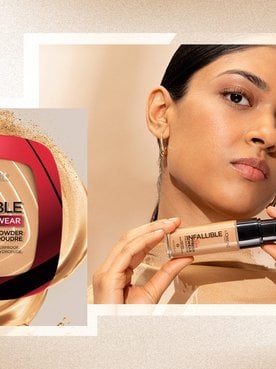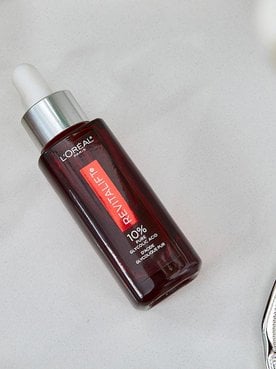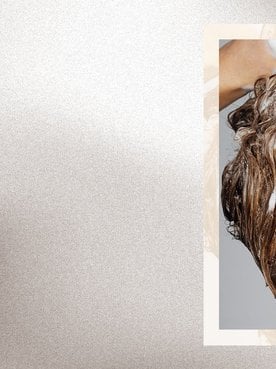A root smudge is the perfect solution for anyone with naturally dark hair hoping to go lighter (or even blonde) without worrying about root upkeep. While there are so many gorgeous shades of blonde, from honey blonde to platinum, trading your dark strands for a lighter alternative certainly isn’t low maintenance. But, this lesser-known hair coloring technique could be the secret to widening the gap between those salon visits while still allowing you to rock an all-over blonde hair color. Read on to find out more about the root smudge technique, learn how to do a root smudge at home, and discover why it’s a match made in heaven for aspiring blondes.
What is a Root Smudge?
Root smudging is a hair coloring technique in which the hair is lightened, but the roots are left slightly darker—typically, within a shade or two of your natural hair color. Done properly, the root smudge creates a smooth, gradual transition between the darker shade at your roots and the lighter hue on your mid-lengths and ends. The technique makes grow-out practically seamless: Since your root color is close to your natural hue, you won’t have any harsh, obvious lines as your hair grows out. While root smudging is popular amongst brunettes who want to go blonde with minimal maintenance, the technique works well for any dark-to-light hair color transformation.
Root Smudge vs. Shadow Root
The main difference between a root smudge and a shadow root is the extent of the gradient. A root smudge generally keeps the darker hue close to your roots, while a shadow root extends the darker hue further down the hair for a more pronounced gradient effect. You can think of a shadow root as a sort of subtle ombré—the transition is meant to be intentional, rather than lived-in.
Both techniques can be useful for those seeking a low-maintenance color, so when choosing between the two, it’s best to consider your desired end result. Smudging roots is a technique best suited for those seeking a natural, lived-in look. A shadow root, meanwhile, will typically yield a more defined, obvious color gradient.
Root Smudge vs. Root Melt
Like a root smudge and a shadow root, a root melt is designed to help create a natural transition between your root color and your lighter, dyed hair color. However, the techniques—and end results—differ drastically. With a root smudge, the focus is on softening the line at the roots. A root melt, however, blends the color from your roots down through the mid-lengths and often to the ends. This technique creates a seamless, gradient effect where multiple tones melt together, giving you an all-over, fluid color transition.
If you’re looking for a more subtle fade that’s concentrated on the roots, a root smudge is your best choice. But, if you want a softer, more dynamic color shift that continues down the length of your hair, the root melt is the way to go.
How To Do a Root Smudge
Now that you know what the root smudge technique is, you may be wondering whether you can do it yourself. The answer is yes—you just need the right tools for the job. Fortunately, the L’Oréal Paris Superior Preference Balayage At-Home Highlighting Kit has everything you need to nail your DIY root smudge—and the process is simpler than you may expect. Ahead, we’re breaking down the step-by-step to help you nail your at-home color transformation.
1. Choose a color
Before you get started, you’ll need to select the right coloring kit for your needs. The L’Oréal Paris Superior Preference Balayage At-Home Highlighting Kit comes in three shades: Light to Dark Blonde, Dark Blonde to Light Brown, and Medium to Dark Brown. Keep in mind that these shades refer to your natural hair color, not the highlight color. If you have lighter hair and want to create a blonde root smudge, opt for one of the two lighter kits. Those with chocolate brown hair or darker, meanwhile, will want to grab the dark brown kit. It’ll yield bright but natural-looking caramel blonde highlights with a perfectly blended root smudge.

2. Section your hair
Starting with dry strands, brush your hair to remove any knots or tangles. Then, use a rat-tail comb to divide your tresses into two sections, as if you were creating pigtails. Clip away one section to keep it out of the way while you work on the other.
3. Lighten your mid-lengths and ends
Next, don your gloves and mix the developer and hair color as instructed in the package insert. Immediately after, begin applying your balayage highlights using the kit’s pro-touch applicator. Brush the mixture along each strand in one smooth, fluid motion to ensure your ends are fully saturated. From there, repeat the process until you’ve applied your balayage highlights around your entire head.
4. Shampoo
Let the color process for the amount of time dictated in the product instructions (typically, between 25 to 45 minutes). Then, hop in the shower and rinse your hair well before lathering up with a gentle, color-safe shampoo. We’re fans of the L’Oréal Paris EverPure Sulfate Free Bond Repair Shampoo with Citric Acid, which is designed specifically for damaged, color-treated hair.
5. Apply root smudger mask
Next, apply the kit’s Pro Toning Mask to your mane, taking extra care to ensure coverage at the roots. Let the mask sit for about ten minutes, then rinse your hair with lukewarm water and style as usual. You’ll enjoy dimensional balayage highlights with a natural-looking blurred root.
Shop the Products
How Long Does a Root Smudge Last?
How long a root smudge lasts depends on your natural color, dyed hair color, and the type of dye you use to smudge your roots. In general, you can expect a root smudge to last around two months before you need to touch it up. Root melts and shadow roots can last a bit longer since the root color is blended further down the hair shaft.
To extend the life of your color—both at the roots and throughout your lengths—we recommend cutting back on heat styling, washing your hair less often, and using color-safe products when you do lather up. Adding a tinted hair gloss to your routine can be helpful too, especially if you’re hoping to stretch out the time between touch-ups. Fortunately, the whole point of a root smudge is to ensure a more seamless grow-out—so if you do go past the two-month mark, it shouldn’t be too obvious.
Next Up: How To Dye Hair at Home in 8 Easy Steps
Photo credit: Mary Todd Lewis, IG/@balayageby_mtlewis







